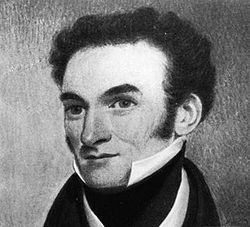
John Busby
Encyclopedia

Surveying
See Also: Public Land Survey SystemSurveying or land surveying is the technique, profession, and science of accurately determining the terrestrial or three-dimensional position of points and the distances and angles between them...
and civil engineer
Civil engineer
A civil engineer is a person who practices civil engineering; the application of planning, designing, constructing, maintaining, and operating infrastructures while protecting the public and environmental health, as well as improving existing infrastructures that have been neglected.Originally, a...
, active in Australia.
Early life
Busby was born in AlnwickAlnwick
Alnwick is a small market town in north Northumberland, England. The town's population was just over 8000 at the time of the 2001 census and Alnwick's district population was 31,029....
, Northumberland, England, eldest son of George Busby, a miner and coalmaster of Stamford, and his wife Margaret, née Wilson, of Dunstan, Northumberland. Busby became a coal miner and later a mineral surveyor and civil engineer in Scotland
Scotland
Scotland is a country that is part of the United Kingdom. Occupying the northern third of the island of Great Britain, it shares a border with England to the south and is bounded by the North Sea to the east, the Atlantic Ocean to the north and west, and the North Channel and Irish Sea to the...
, and was employed on various public work projects, including the provision of a water-supply for Leith
Leith
-South Leith v. North Leith:Up until the late 16th century Leith , comprised two separate towns on either side of the river....
fort. Busby received two of the Highland Society's highest premiums; firstly for inventing machinery for ascertaining the nature of rock strata by boring, and secondly for developing a method of sinking through quicksands, clay and gravel beds. In 1810 he was employed on the Irish estate of the marquess of Downshire.
Australia
Busby and his family emigrated to New South WalesNew South Wales
New South Wales is a state of :Australia, located in the east of the country. It is bordered by Queensland, Victoria and South Australia to the north, south and west respectively. To the east, the state is bordered by the Tasman Sea, which forms part of the Pacific Ocean. New South Wales...
, Australia arriving at Sydney on 24 February 1824. He was engaged as mineral surveyor and civil engineer to the colony at a salary of £200 a year for 200 days in each year.
In June 1825 Busby made an interesting report on the state of the water-supply of Sydney, and suggested that a supply could be drawn from "the large lagoon in the vicinity of the paper mill" to a reservoir in Hyde Park
Hyde Park, Sydney
Hyde Park is a large park in Sydney, New South Wales, Australia. Hyde Park is on the eastern side of the Sydney central business district. It is the southernmost of a chain of parkland that extends north to the shore of Port Jackson . It is approximately rectangular in shape, being squared at the...
from which it would be distributed throughout the city by pipes. The mill referred to was in the neighbourhood of the present corner of Bourke and Elizabeth Streets
Elizabeth Street, Sydney
Elizabeth Street is a street in Sydney, Australia.-Description and history:Elizabeth Street runs south from Hunter Street, past Hyde Park and David Jones, Central station and through the inner city suburbs of Surry Hills, Redfern, Waterloo and Zetland...
, Waterloo
Waterloo, New South Wales
Waterloo is an inner-city suburb of Sydney, New South Wales, Australia. Waterloo is located 4 kilometres south of the Sydney central business district and is part of the local government area of the City of Sydney.-History:...
. In January 1826 he made a second report, in which he suggested expense could be saved by driving a tunnel into Sydney. This was begun, and in February 1829 Governor Darling
Ralph Darling
General Sir Ralph Darling, GCH was a British colonial Governor and Governor of New South Wales from 1825 to 1831.-Early career:...
stated in a dispatch that it was "quite impossible to dispense with Busby so long as the work in which he is employed introducing water into Sydney is in operation".
Busby's salary had in the meantime been increased to £500 a year, and the colonial office had questioned the necessity of retaining his services any longer and demanded a report on the project in 1832. The water-supply scheme was not completed until September 1837. It had involved the excavation of a tunnel about 12,000 feet (3,660 m) long, but the proposed reservoir at Hyde Park with pipes throughout the city was not gone on with. Busby's appointment terminated on the completion of the waterworks, and in August 1838 the payment to him of a sum of £1000 was sanctioned as a gratuity.
Late life
Busby retired to his country property Kirkton on the Hunter River which had been granted to him and died there on 10 May 1857. He married Sarah Kennedy in 1798 and was survived by children.Sydney's first efficient water supply became known as "Busby's Bore
Busby's Bore
Busby's Bore was Sydney's second water supply. It was built by convict labour and completed in 1830.-History:By the 1820s, the Tank Stream, Sydney's original water supply, was in dire straits...
". In this he was assisted by his son, William.
He was the father of James Busby
James Busby
James Busby is widely regarded as the "father" of the Australian wine industry, as he took the first collection of vine stock from Spain and France to Australia. Later he become a British Resident who traveled to New Zealand, involved in the drafting of the Declaration of the Independence of New...
, who was to become a major figure in the Australian wine-making industry.
External links
- John Busby bio at Bright Sparcs
- John Busby and Busby's Bore (pdf)

